Over the past two years I have been searching for a family of foxes to photograph, with little success. I live in southern Alberta and we have red foxes aplenty, but my search for them has not been fruitful.
A few weeks ago I was looking for burrowing owls in the Manyberries, Alberta area.
I was driving along when suddenly a pair of pointed ears popped out of the grass. I stopped the car and backed up to where I thought I had spotted them.
Although I did not see the fox immediately, I did see what looked to be the top of the fox den. I was confident I had seen the ears, so I parked the car and waited.
Not long after the vixen of the den popped her head out and promptly disappeared for another hour or so after spotting me.
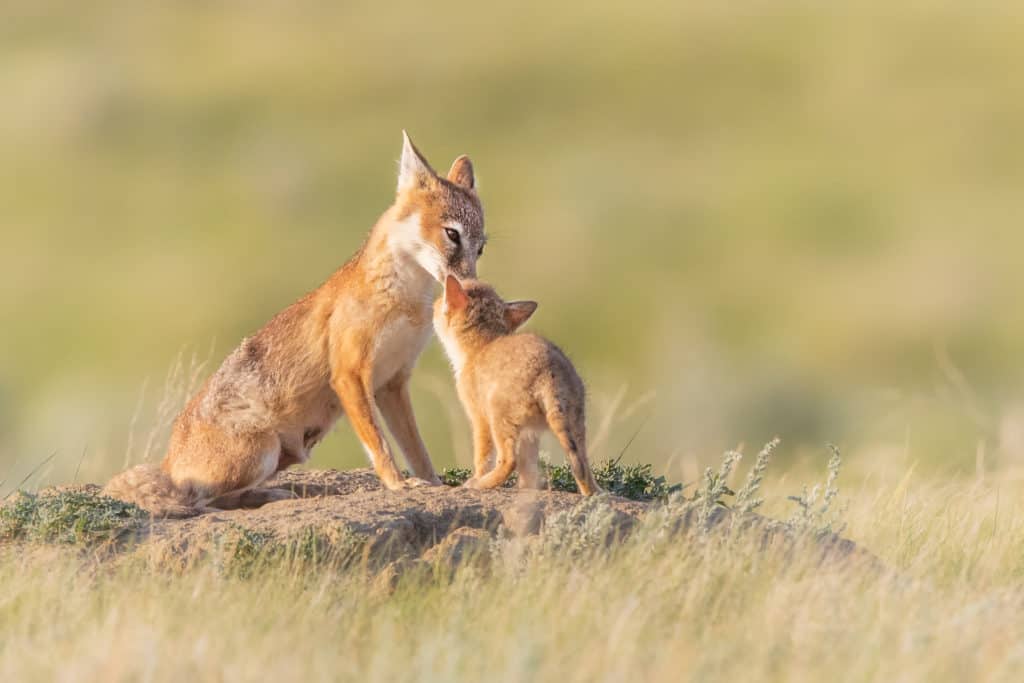
I got out of the car and took my camera and beanbag support along and hopped the fence. I set up about 100′ from the hole and propped my Canon 5D Mark 4 and 600mm F4 IS2 on the beanbag for support.
Very shortly after the fox came out of the den, along with several kits.
I spent the rest of the day with these foxes until it was too dark to shoot any more. It turns out that these foxes were swift foxes (vulpes velox) and not the ubiquitous red fox commonly found in Canada which made the sighting even more unique.
Although it was my first time shooting a fox family I learned a lot in those few hours and want to share that with you.
Swift Fox Photography Tips
Tip #1-Patience. Be prepared to spend the better part of a day with them.
I can not stress this point enough. After the vixen came out of the den and I had captured a few sharp shots of her, the excitement of wanting to go back and edit the photos was tough to suppress.
I spent around 5 hours laying in that field with the foxes, and almost all of my best photos came after sunset. Not only was the lighting softer and more even, the foxes at that point had become quite comfortable with me hanging around their den.
Several times the male fox came within 15 feet of me, with barely a sidewards glance. The female (vixen) remained somewhat skittish throughout the afternoon, taking the job of protecting her kits very seriously.
Spending more time with them allows you to anticipate their moves and allows you to frame and refocus accordingly. It also allows you to see them in many different situations. I watched them hunt, eat, watched the kits latch onto mom while mom slept, and watched the male stealthily hunt his prey…
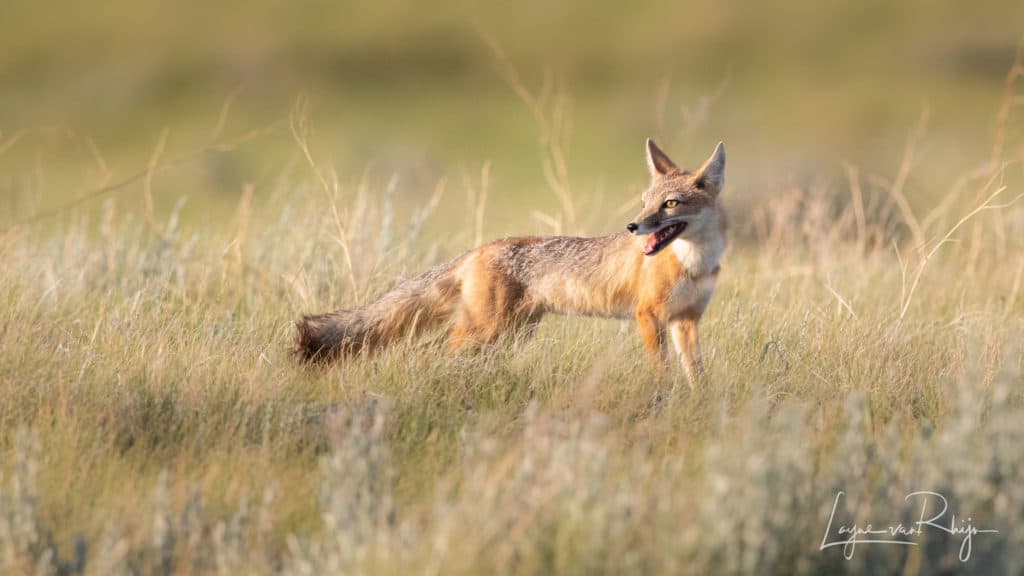
Tip #2-Make sure your camera is set to “servo” or “continuous focus”.
The fox is a fast moving animal and quite “twitchy”. Be sure to set your camera to AF-Servo or Continuous Focus. This allows the camera to continually focus, and it doesn’t matter whether the fox is moving towards or away from the camera.
Depending on how close I am to the animal I use center point or expanded center point depending on how I am framing the fox. I usually use the center point and move it around to cover the eyes of the fox.
If you only use single focus you will notice that many shots will be out of focus, as the fox does not sit still for long. It is not like a hawk or an owl on a post that may not move for 15 to 20 seconds, it just always seems to be moving. Using servo mode will ensure the lens stays locked on the eyes of the fox, keeping them as sharp as possible.
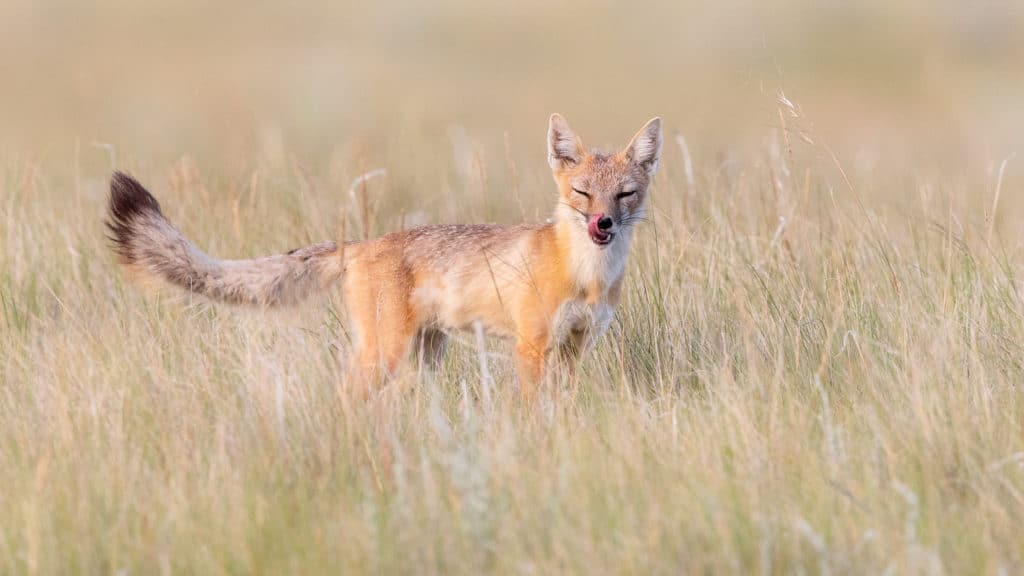
Tip #3-Don’t leave when the sun goes down; my best photos of this fox family were long after the sun had set.
I was concerned that the light would be too low after the sun had set, but I could not be more wrong.
I was using the Canon 5D Mark 4 for these photos, which does fairly well in low light. Typically I try to keep my ISO as low as possible, as I like to print my photos where graininess or “noise” is more visible than on a small screen.
With the low light I had to compromise on the ISO somewhat, and was shooting at around 4000 ISO in order to keep the shutter speed high enough to keep the fox sharp.
The evening sky took on a beautiful blue & magenta glow, and complemented the orange and grey coat of the fox beautifully.
Another added benefit (something I learned while researching burrowing owl photography) was that the pupils of the fox became much larger, and added much more “soul” to the animal versus the pinpoint pupils they had when the sun was still up. It really does add a lot to the photo…
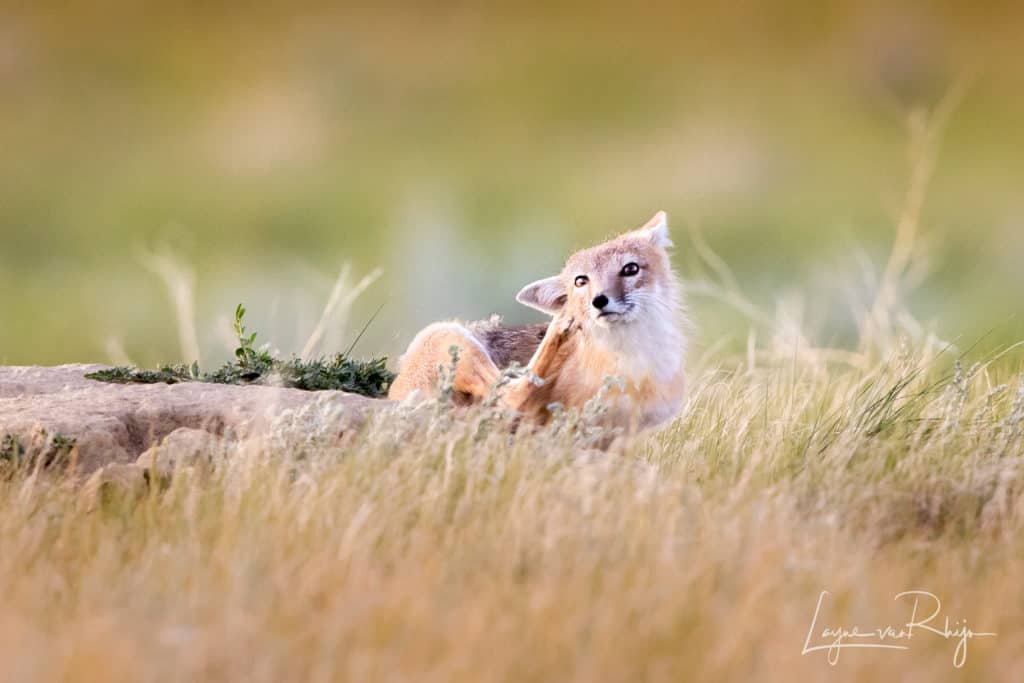
Tip #4-No sudden movements. Ever.
Over the course of the afternoon I had continuously been moving closer to the fox den. At one point my arms started to cramp up a bit and I decided to sit up and stretch.
It basically “reset” all the work I done to get the foxes comfortable with my presence. I sat up abruptly and the whole family dove into their den, not to come out again for close to an hour.
Lesson learned. The rest of the day I inched along very slowly towards the den. As long as I moved slowly and non-threateningly they tolerated me, often times even ignoring me.
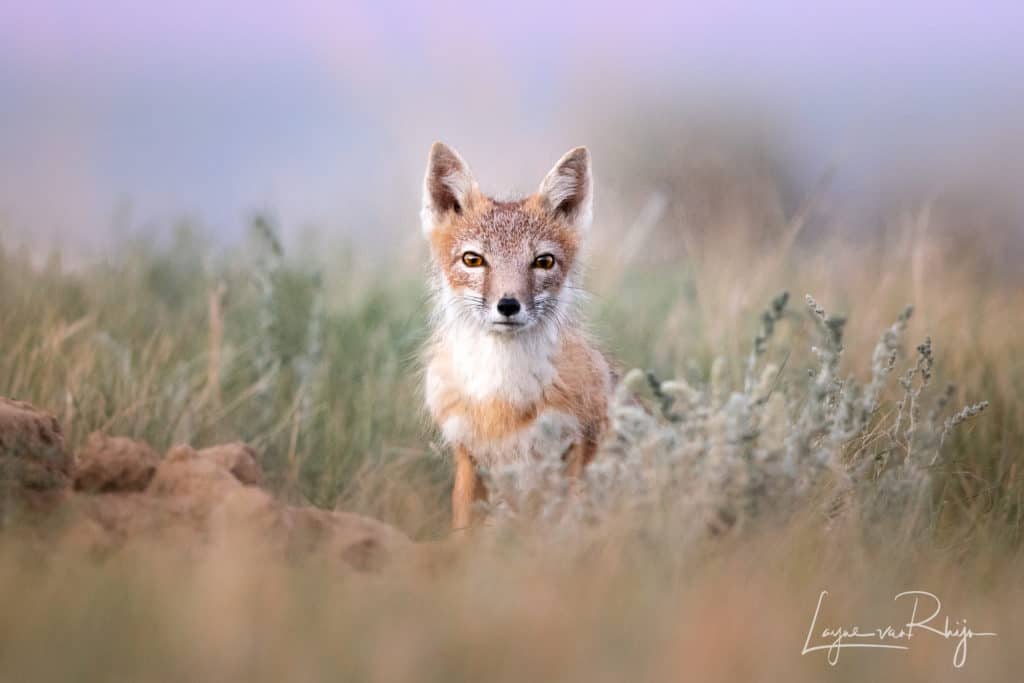
Tip #5-Make sure the sun is at your back, even when it goes down.
As with any animal, the eyes are often the focal point of an image. My first images of the group were with the sun at a right angle to the fox.
When I later moved into the field and positioned the sun at my back it was much easier to get nice catchlights in the eyes of the foxes.
This is also true when the sun is down below the horizon. Even though there is no longer a direct light source the light still comes from somewhere.
If you look at the image below you can see beautiful catchlights in the eyes of the fox that would not be there had I shot it from the other side with the sun at his back.
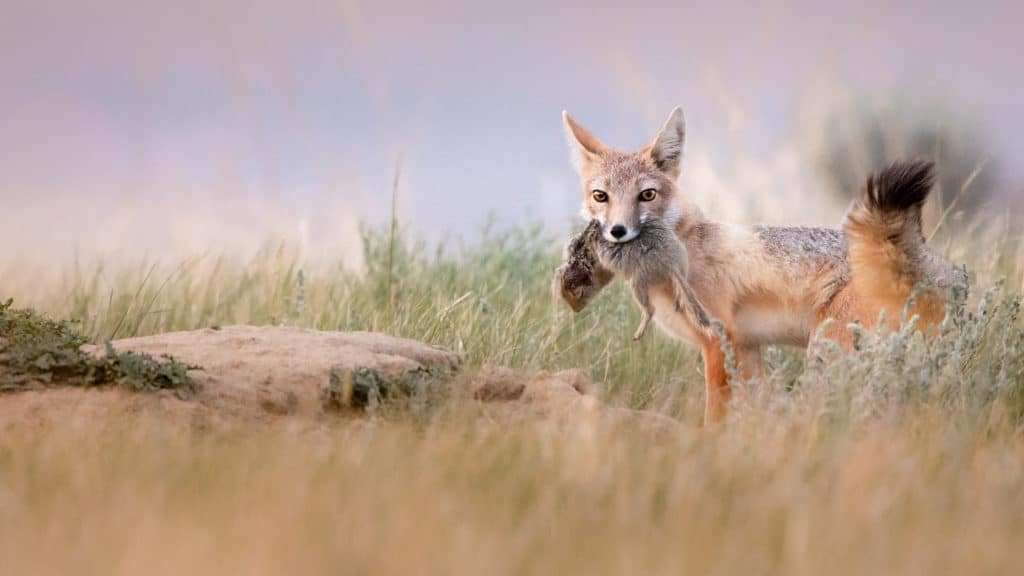
Tip #6-Ditch the tripod, use a beanbag.
I can not stress enough how important it is to get low to the ground, at or slightly below the eye level of the animal. I see many photographers stand bolt upright pointing their cameras down towards the animal. This is rarely a good photographic angle when it comes to wildlife photography.
Most tripods won’t allow you to position the lens close enough to the ground, especially when supporting the weight of a giant lens such as the Canon 600mm F4 IS2 lens I was using.
For most of my animal photography I use a Lenscoat beanbag filled with sunflower seedsto stabilize my camera and lens.
I usually position it under the front of the lens (as opposed to the middle) so that when I move my camera slightly the end of the lens barely moves. I find that when mounted on the foot of the lens a slight movement of the camera translates to a large movement on the end of the lens due to increased leverage.
It is also much easier to move a beanbag around than a tripod setup with camera attached. When working with skittish animals it is important to keep a low profile and and to keep movements to a minimum.
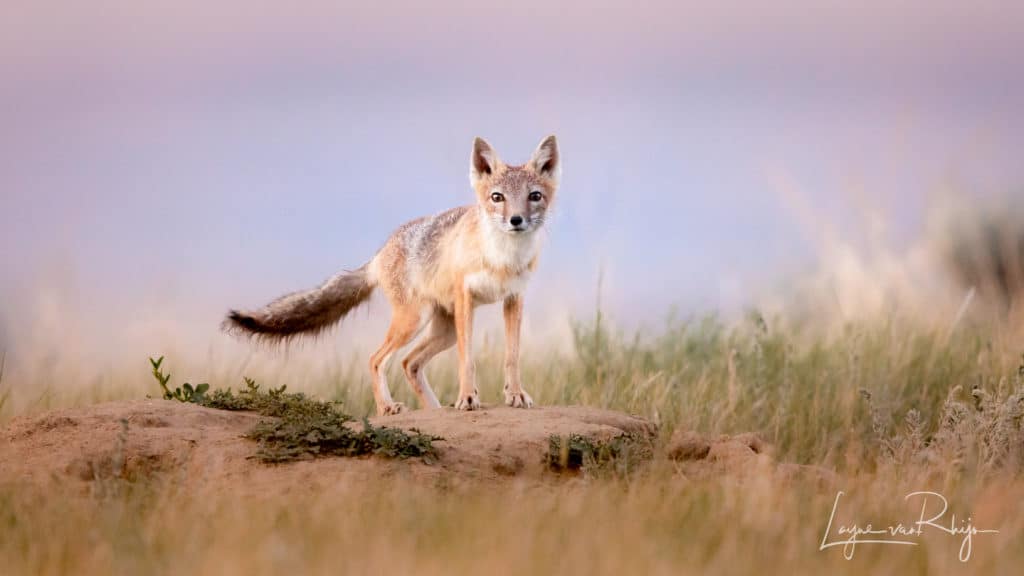
Tip #7. Don’t startle if they come and check you out.
I can’t yet speak for red foxes, but the swift foxes I have spent time with have been very inquisitive.
The first time it took about an hour after my arrival when suddenly the male fox left the den and headed straight towards me.
It came so close that my 600mm lens would no longer focus due to the minimum focussing distance.
This has happened almost every single time I have spent any length of time with swift foxes.
I will sit about 60-70 feet away from the den to let them get used to me and then slowly start working my way closer. Almost every single time the male swift fox (never the female so far) will leave the den withing about 1/2 an hour to an hour of me arriving and head straight at me.
Even though the swift fox is tiny the first time it really startled me when it walked confidently right at me to within 10 feet and then sat down.
The last few times they have headed straight at me and then calmly sauntered by after giving me a once over. Be prepared, because often this is when I get my best photos (remember, servo mode and burst photos are your friend).
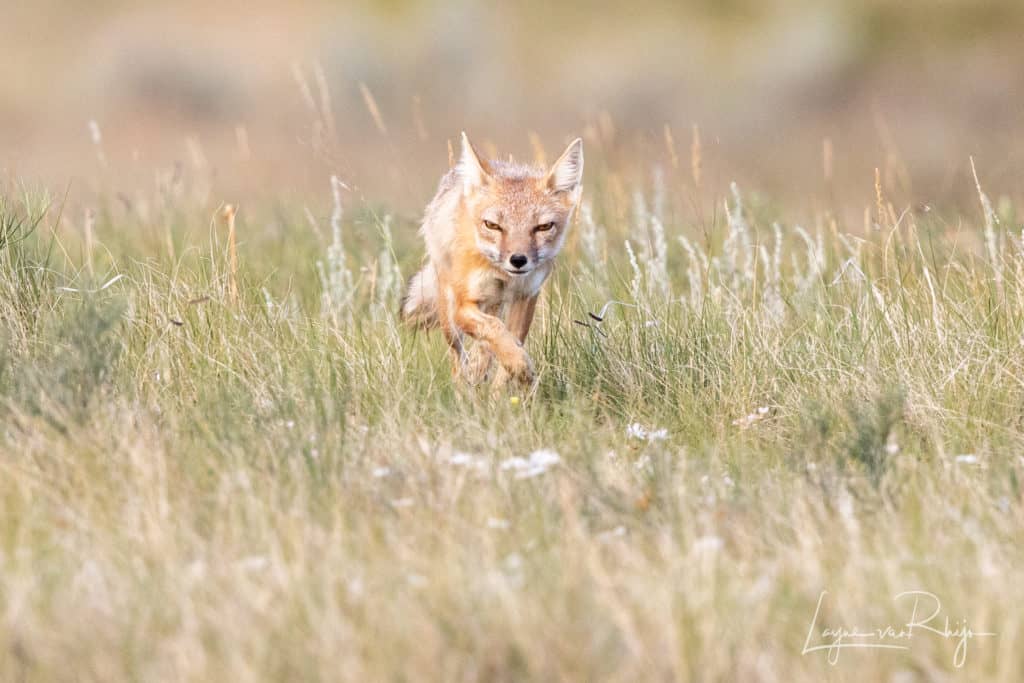
I will update this post with new fox photography tips as I learn them. In the coming weeks as I hope to be spending some more time with this swift fox family and can’t wait to share some more photos.
(Update August 7, 2018: After messaging Nature Conservancy Canada via Facebook and sending them the location of the first swift fox den I had encountered, Global News did a small piece on the reintroduction of swift foxes into Canada and used some trail cam footage of the same den! Here is the link: https://globalnews.ca/news/4371530/swift-foxes-back-from-extinction-canada/)
(Note: I edit all my photos in Adobe Lightroom and occasionally in Photoshop. I’m working on compiling a list of the techniques I use to edit my wildlife photos and will have it available on the home page soon!)
To see a gallery of my wildlife images please visit https://www.laynevanrhijn.photo/Photo-Galleries/Wildlife/
